Find more information in the General Comments section of the assessment
Find more information in the Rating Validity tab of the assessment
-
Adult Occupant
See More 70%
70% -
Child Occupant
See More 77%
77% -
Pedestrian
See More 50%
50% -
Safety Assist
See More 46%
46%
- Good
- Adequate
- Marginal
- Weak
- Poor
 Passenger
Passenger
 Driver
Driver
 Rear Passenger
Rear Passenger
 Driver
Driver
 Car
Car
 Pole
Pole
 Rear Seat
Rear Seat
 Front Seat
Front Seat
- Good
- Adequate
- Marginal
- Weak
- Poor


Passenger
outboard
center
Fitted to the vehicle as standard
Not fitted to the test vehicle but available as option
Not Available
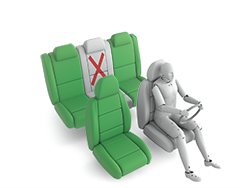
-
Infants up to 13 kg
-
Infants and toddlers up to 18 kg
-
Toddlers from 9 to 18 kg
-
Toddlers over 18 kg
Easy
Difficult
Safety critical
Not allowed
| Seat Position | ||||
|---|---|---|---|---|
| Front | 2nd row | |||
| Passenger | Left | center | Right | |
| Maxi Cosi Cabriofix (Belt) | ||||
| Britax Römer King Plus (Belt) | ||||
| Britax Römer Duo Plus (ISOFIX) | ||||
| Britax Römer KidFix (Belt) | ||||
| Maxi Cosi Cabriofix & EasyFix (Belt) | ||||
| Maxi Cosi Cabriofix & EasyFix (ISOFIX) | ||||
| BeSafe iZi Kid X3 ISOfix (ISOFIX) | ||||
| Maxi Cosi Pearl & Familyfix (ISOFIX) | ||||
| Britax Römer KidFix (ISOFIX) | ||||
Easy
Difficult
Safety critical
Not allowed
The Panda Cross scored maximum points in the dynamic impact tests for its protection of the 1½ year and 3 year dummies, both of which were sat in rearward-facing restraints. In the side barrier test, both dummies were properly contained within the protective shells of their restraints, minimising the likelihood of head contact with parts of the vehicle interior. The front passenger airbag can be disabled to allow a rearward-facing child restraint to be used in that seating position. However, the switch to deactivate the airbag is not clearly labelled and the system was not rewarded by Euro NCAP. All of the restraint types for which the car is designed could be properly installed and accommodated in the car.
- Good
- Adequate
- Marginal
- Weak
- Poor

Head Impact 12.4 Pts
Pelvis Impact 5.1 Pts
Leg Impact 0.8 Pts
The bumper offered predominantly poor protection to pedestrians' legs, while the protection offered to the pelvis region was mostly good. Tests on the bonnet surface showed predominantly adequate or marginal protection for the head of a struck pedestrian, with poor results recorded along the base of the windscreen and along the stiff windscreen pillars.
- Good
- Adequate
- Marginal
- Weak
- Poor
| Performance | ||
| Vehicle Yaw Rate @ COS + 1.00 s | 0% | meets ECE requirements |
| Vehicle Yaw Rate @ COS + 1.75 s | 0% | meets ECE requirements |
| Lateral Displacement @ BOS + 1.07 s | 2 m | meets ECE requirements |
| Applies To | All seats | ||
| Warning | Driver Seat | Front Passenger(s) | Rear Passenger(s) |
| Visual | |||
| Audible | |||
|
|||
The Panda Cross has electronic stability control as standard equipment, together with a seatbelt reminder for the front and rear seating positions. Neither a speed limitation system nor a lane assist system are available and the Panda Cross does not have autonomous emergency braking.
- Specifications
- Safety Equipment
- Videos
- Rating Validity
Specifications
Tested Model FIAT Panda Cross 1.3 MJ 4X4
Body Type - 5 door hatchback
Year Of Publication 2015
Kerb Weight 1150kg
VIN From Which Rating Applies - all Panda Cross of the specification tested
Class Small Off-Road 4x4
Safety Equipment
Note: Other equipment may be available on the vehicle but was not considered in the test year.
Fitted to the vehicle as standard
Fitted to the vehicle as option
Not fitted to the test vehicle but available as option
Not Available
Not Applicable
Videos
Rating Validity






Find more information in the General Comments section of the assessment
 Share
Share
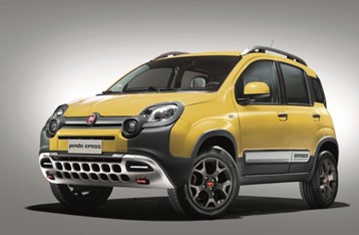
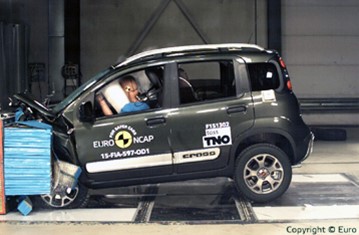
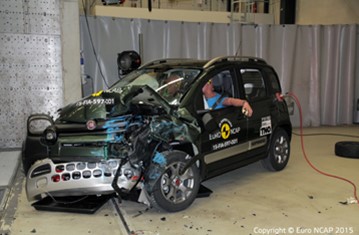
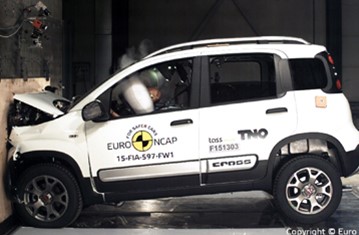


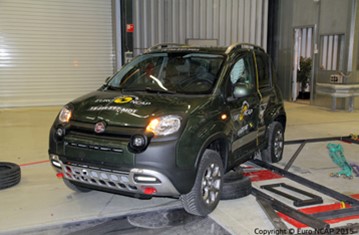
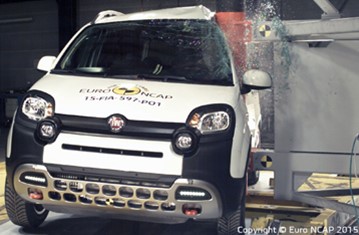




The passenger compartment remained stable in the frontal offset test. Examination of the dummy readings and the high-speed films revealed that the head had made contact, through the deflating airbag, with the steering wheel. A penalty was applied and the driver's head protection was rated as adequate. At around the same time during the impact, with insufficient gas in the airbag, the chest contacted the rim of the steering wheel and, combined with dummy readings for chest compression, its protection was rated as weak. Dummy readings indicated good protection of the knees and femurs of the driver and front passenger. Fiat showed that a similar level of protection would be provided to occupants of different sizes and to those sat in different positions. In the full-width rigid barrier test, protection of the driver's chest was marginal, despite the standard-fit seatbelt pretensioners and load-limiters. Without these, protection of the rear seat occupant was rated as poor for the head and the chest, and weak for the neck. In the side impact barrier test, the Panda Cross scored maximum points with good protection of all body areas. In the more severe side pole test, protection of all body areas was good except the chest, protection of which was adequate. Dynamic tests and geometric assessments indicated marginal protection against whiplash injuries for the front and rear seat occupants.